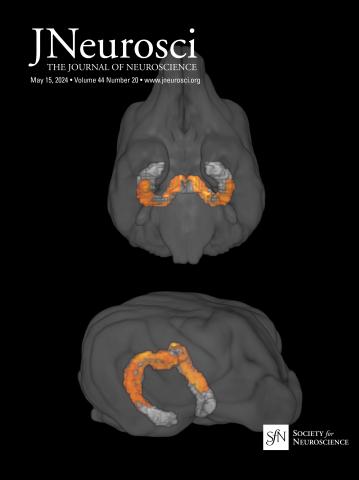Neural and Behavioral Markers of Negative Symptoms and Cognitive Impairment in Patients with Psychosis.
IF 4
2区 医学
Q1 NEUROSCIENCES
引用次数: 0
Abstract
Negative and cognitive symptoms impair functioning in patients with psychotic illnesses (i.e., schizophrenia spectrum disorders (SZ) and bipolar I disorder with psychotic features (BD)). Disruptions in mesocorticolimbic circuitry are hypothesized to underpin negative symptoms and cognitive impairment in patients with psychosis and may also facilitate reward-motivational deficits. In male and female patients with psychosis (N=44) and healthy controls (HC=27), we used neuroimaging to define gray matter morphology and white matter microstructure. We examined negative symptom severity with the Clinical Assessment Interview for Negative Symptoms (CAINS), effort allocation during reward processing with the Effort Expenditure for Rewards Task (EEfRT), and cognitive performance with the MATRICS Cognitive Consensus Battery (MCCB). Reduced nucleus accumbens volumes in patients with psychosis were associated to higher CAINS total and Motivation and Pleasure subscale scores as well as lower effort expenditure for medium (50%) and high (88%) reward probability conditions during the EEfRT. The fornix showed reduced fractional anisotropy in patients with psychosis. Negative associations were present between CAINS Motivation and Pleasure subscores and MCCB composite and subscale scores. Lower gray matter volume in cerebellar lobule VI corresponded with impaired effort allocation during medium and high reward probability conditions and lower cognitive performance. However, lobule VI was not correlated with CAINS scores. While nucleus accumbens volume may serve as marker of negative symptoms in psychotic illnesses, cerebellar lobule VI morphology may inform on cognitive impairment in patients with SZ and BD. The nucleus accumbens and lobule VI may each contribute to reduced effort allocation during reward processing.Significance Statement Improving negative symptoms and cognitive impairment in SZ and BD remains an unmet clinical need. This study reveals that, in SZ and BD, structural changes in the nucleus accumbens and cerebellar lobule VI are associated with negative symptoms and cognitive impairments, respectively. The current findings also suggest that reductions in nucleus accumbens and cerebellar lobule VI volume may also underpin impaired reduced effort allocation during reward processing. This study provides impetus for further probing supratentorial and cerebellar circuitry to further understand negative and cognitive symptoms experienced by patients with psychotic illness and their associations with reward-motivational deficits.精神病患者阴性症状和认知障碍的神经和行为标志物
阴性和认知症状损害精神病患者(即精神分裂症谱系障碍(SZ)和具有精神病特征的双相I型障碍(BD))的功能。假设中皮质边缘电路的中断是精神病患者阴性症状和认知障碍的基础,也可能促进奖励动机缺陷。在男性和女性精神病患者(N=44)和健康对照(HC=27)中,我们使用神经影像学来确定灰质形态和白质微观结构。我们用阴性症状临床评估访谈(CAINS)检查了阴性症状的严重程度,用奖励任务的努力支出(EEfRT)检查了奖励处理过程中的努力分配,用矩阵认知共识电池(MCCB)检查了认知表现。精神病患者伏隔核体积的减少与较高的CAINS总分和动机与愉悦亚量表得分以及在EEfRT中(50%)和高(88%)奖励概率条件下较低的努力支出有关。精神病患者穹窿各向异性分数降低。CAINS动机与愉悦分值与MCCB复合分值和子量表分值呈负相关。在中、高奖赏条件下,小脑第六小叶灰质体积减少与努力分配受损和认知表现下降相对应。然而,小叶VI与CAINS评分没有相关性。伏隔核的体积可以作为精神疾病阴性症状的标志,而小脑第六小叶的形态可以反映SZ和BD患者的认知障碍。在奖励处理过程中,伏隔核和第六小叶可能都有助于减少努力分配。改善SZ和BD的阴性症状和认知功能障碍仍未满足临床需求。本研究发现,在SZ和BD中,伏隔核和小脑六小叶的结构变化分别与阴性症状和认知障碍有关。目前的研究结果还表明,伏隔核和小脑第六小叶体积的减少也可能是奖励处理过程中努力分配受损的基础。本研究为进一步探索幕上和小脑回路提供了动力,以进一步了解精神病患者所经历的消极和认知症状及其与奖励动机缺陷的关系。
本文章由计算机程序翻译,如有差异,请以英文原文为准。
求助全文
约1分钟内获得全文
求助全文
来源期刊

Journal of Neuroscience
医学-神经科学
CiteScore
9.30
自引率
3.80%
发文量
1164
审稿时长
12 months
期刊介绍:
JNeurosci (ISSN 0270-6474) is an official journal of the Society for Neuroscience. It is published weekly by the Society, fifty weeks a year, one volume a year. JNeurosci publishes papers on a broad range of topics of general interest to those working on the nervous system. Authors now have an Open Choice option for their published articles
 求助内容:
求助内容: 应助结果提醒方式:
应助结果提醒方式:


